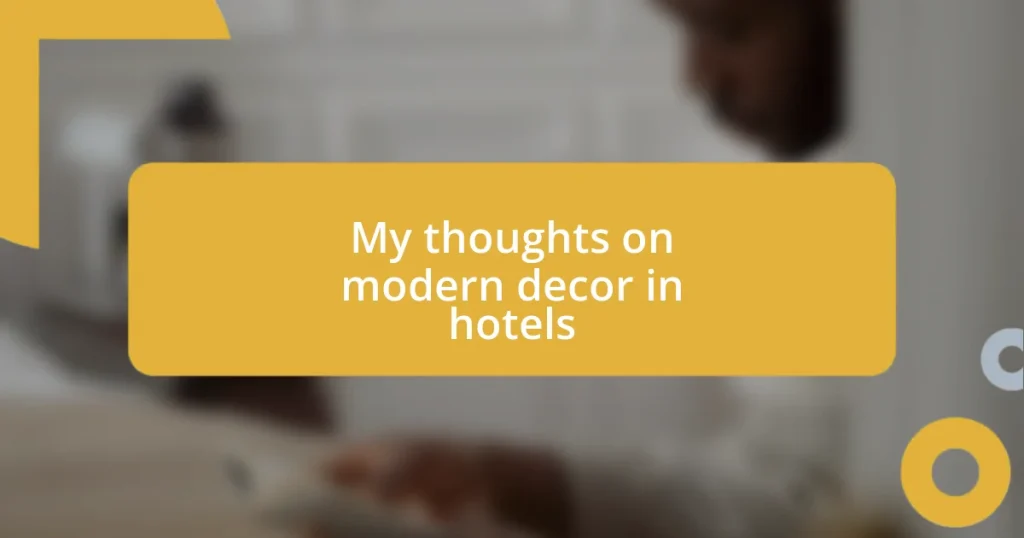Key takeaways:
- Modern hotel decor balances functionality and aesthetics, enhancing guest experiences through thoughtful design elements like natural materials, lighting, and layout.
- First impressions play a crucial role in setting the tone for a stay, with aesthetics and emotional resonance contributing significantly to guests’ perceptions and memories.
- Future trends in hotel decor will focus on personalization, multi-functional spaces, and integration of local culture, creating authentic and adaptable guest experiences.
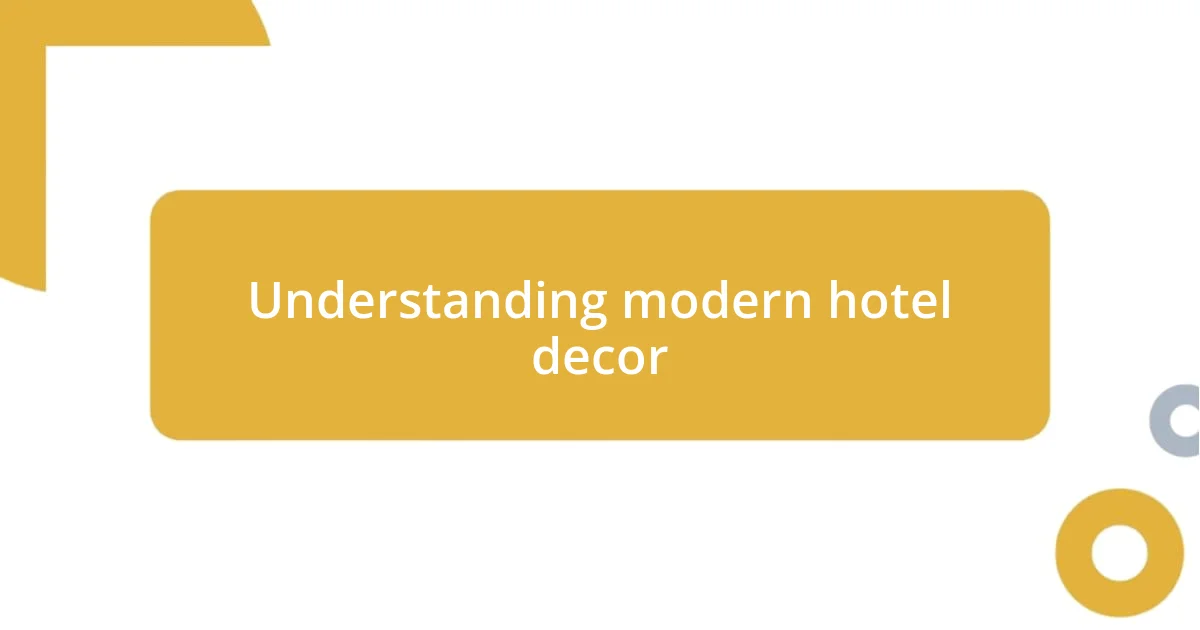
Understanding modern hotel decor
Modern hotel decor is a fascinating blend of functionality and aesthetics. I remember walking into a chic boutique hotel where minimalist furniture met vibrant artwork, creating an atmosphere that felt both inviting and energizing. It made me wonder, how much does decor influence our overall experience as travelers?
The use of natural materials, like wood and stone, is becoming increasingly popular in hotel design, and for good reason. I once stayed at a hotel with large windows that framed a breathtaking mountain view while the interior used reclaimed wood accents. That connection to nature resonated with me, turning my stay into a tranquil retreat rather than just a place to sleep. Isn’t it amazing how the right decor can transform your mood?
Lighting plays a pivotal role in modern hotel decor, often setting the entire tone for a space. I vividly recall a hotel lobby where soft, warm light created an inviting ambiance, encouraging guests to linger over coffee and conversation. It got me thinking: could something as simple as lighting really shape our interactions and experiences in a space?

Importance of first impressions
First impressions are crucial when it comes to modern hotel decor. The moment you step into a hotel lobby, how the space looks and feels can either welcome you warmly or leave you feeling unsettled. I recall arriving at a vibrant hotel with a unique sculptural installation that instantly caught my eye. It set the tone for my entire stay, making me feel as if I had entered a creative haven.
The balance of visual elements in a space significantly impacts guests’ perceptions. During a recent visit to a sleek downtown hotel, I was amazed at how the carefully curated art pieces and thoughtfully chosen color palette made the environment feel both luxurious and approachable. That experience reminded me that every detail matters—what we see and feel right away can enhance or diminish our expectations for the entire stay.
Moreover, the first impression goes beyond mere aesthetics; it also encompasses the feelings and memories that a space can evoke. I remember checking into a charming coastal hotel decorated with nautical elements and warm hues. The decor immediately transported me to carefree summers by the beach. That initial emotional connection is something that every hotel should strive to achieve, as it can deeply influence a guest’s overall satisfaction and likelihood of returning.
| Aspect | Impact on First Impressions |
|---|---|
| Aesthetics | Sets the tone for the entire stay |
| Layout | Influences how welcoming and spacious a space feels |
| Emotional Resonance | Creates lasting memories and connections |
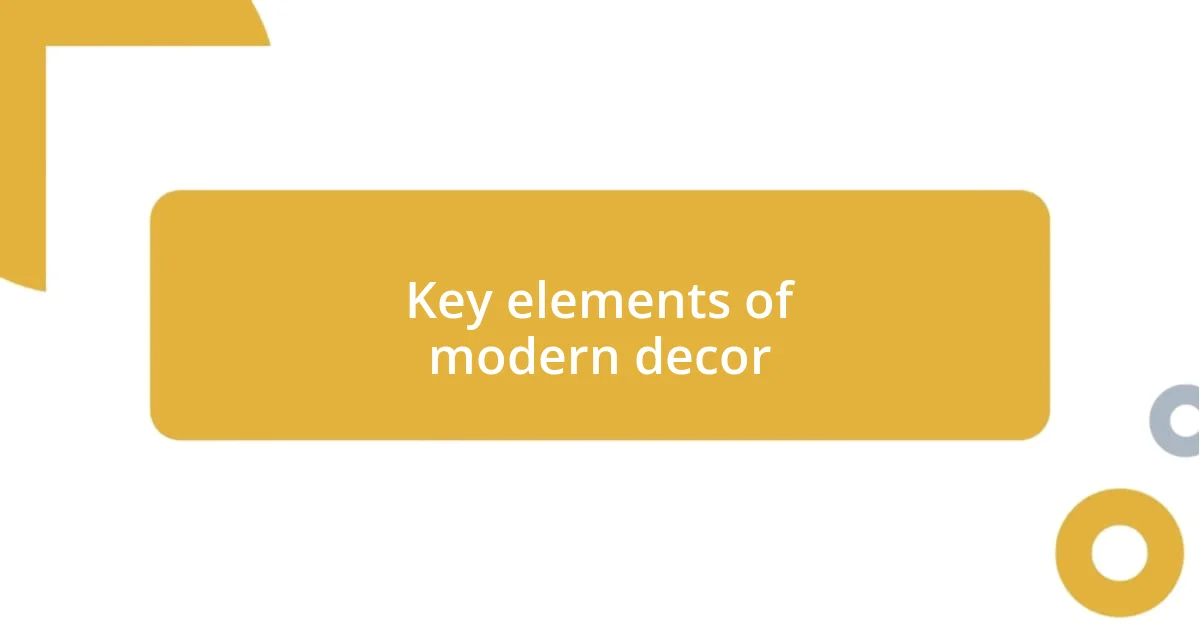
Key elements of modern decor
Modern decor in hotels is marked by a few key elements that transform ordinary spaces into extraordinary experiences. When I think of sleek lines and understated elegance, I often recall a boutique hotel focused on simplicity, where every piece of furniture was not just functional but also a work of art. It was refreshing to see decor that embraced a less-is-more philosophy, allowing guests to appreciate the space rather than feeling overwhelmed by it.
Here are some important elements I believe define modern decor:
- Minimalism: Emphasizes clean lines and uncluttered spaces.
- Natural Elements: Incorporates materials like wood and stone to foster a connection with nature.
- Artistic Touches: Features curated art that sparks creativity and conversation.
- Flexible Spaces: Designs areas that are adaptable for different uses and events.
- Innovative Lighting: Utilizes ambient and accent lighting to create mood and enhance aesthetics.
I distinctly remember a hotel where large art installations punctuated the hallways. Each piece told a story, inviting guests to pause and reflect—an experience that left a lasting impression on me. I realized how powerful thoughtful decor can be in creating a sense of place. It’s not just about looking good; it’s about evoking feelings and forging connections that linger long after the stay.
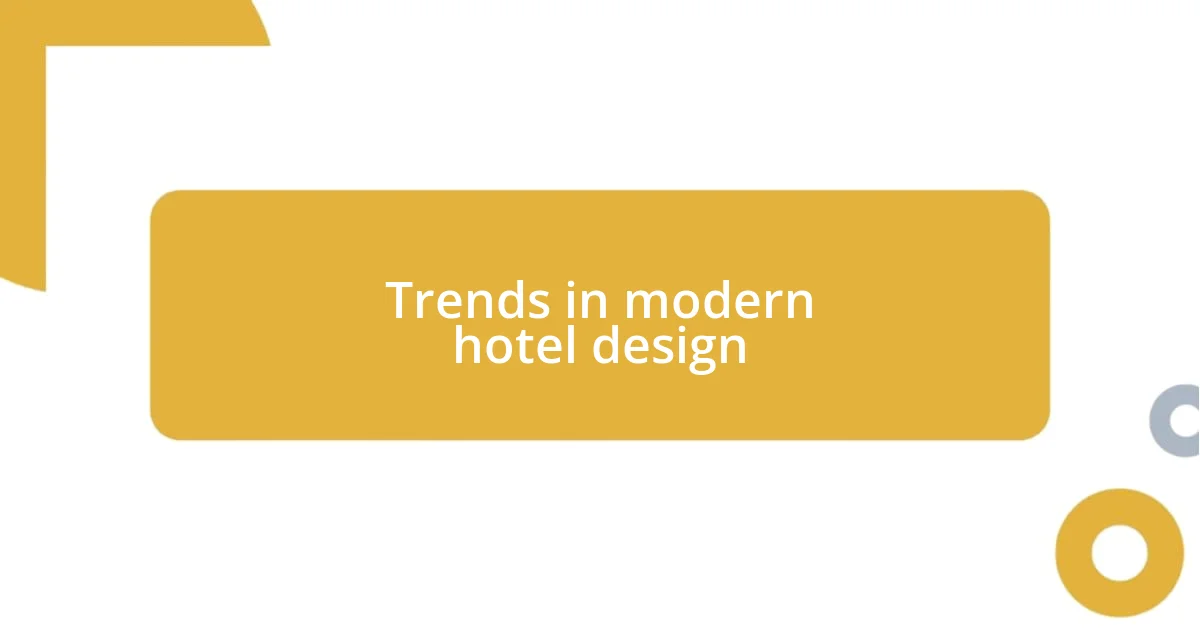
Trends in modern hotel design
Trends in modern hotel design are constantly evolving, reflecting our shifting tastes and values. One standout element I’ve noticed is the integration of biophilic design, which connects guests with nature through indoor plants and natural materials. On a recent stay at a hotel adorned with vertical gardens and natural light flooding through expansive windows, I felt a profound sense of calm and rejuvenation—it was like stepping into an oasis.
Another trend gaining traction is technology-driven design, where smart controls for lighting, temperature, and entertainment make the guest experience ultra-convenient. I remember checking into a tech-savvy hotel where everything was controlled via a user-friendly app on my phone. It was impressive to have such personalized control, yet I wondered—does this high-tech focus sometimes overshadow the human touch that makes a hotel truly inviting?
Sustainable practices are also increasingly woven into hotel design, which adds depth to the aesthetic appeal. I had a remarkable experience at a hotel that utilized reclaimed wood for furnishings and promoted zero-waste initiatives. The atmosphere felt ethically luxurious, making me wonder how these conscious choices not only enhance a hotel’s image but can also transform our own perspectives on travel. Each of these trends illustrates that modern hotel design isn’t just about visual appeal—it’s about creating environments that resonate on a deeper level with guests by aligning with their values and enhancing their overall experience.
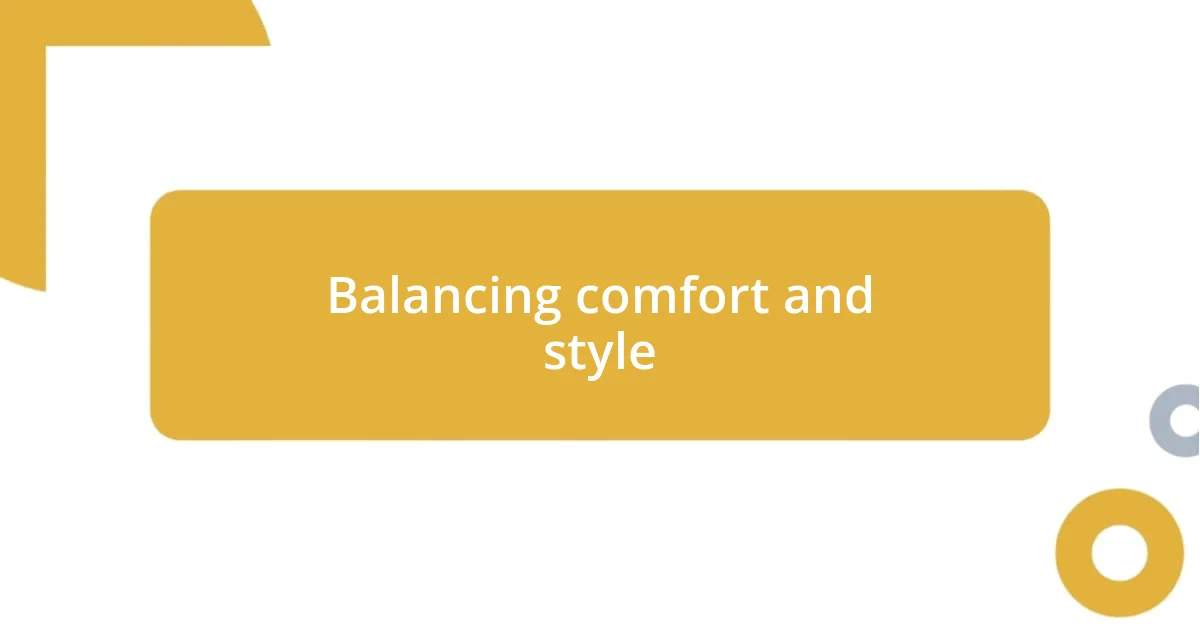
Balancing comfort and style
When it comes to balancing comfort and style in hotel decor, I find it essential for spaces to feel inviting without sacrificing aesthetic appeal. I once stayed in a chic hotel where plush furnishings perfectly complemented sleek design elements. It was incredible how a well-placed velvet sofa not only added sophistication but also beckoned me to sink into its embrace after a long day of exploring. Isn’t it fascinating how the right choices can make us feel both relaxed and inspired?
I’ve also observed that color palettes play a key role in achieving this balance. Neutral tones, for instance, can create a calming atmosphere while allowing for bold accent pieces to shine. I remember being captivated by a hotel that featured soft beige walls alongside striking yellow pillows—an eye-catching contrast that brought warmth and energy to the room. How does a space evoke such a feeling of harmony without overwhelming the senses? It all boils down to thoughtful coordination.
Ultimately, comfort should never feel at odds with style. I experienced this firsthand at a boutique hotel that fused cozy textiles with modern art pieces. The moment I curled up in a soft throw while admiring a contemporary sculpture, I realized that both elements enhanced each other beautifully. Isn’t it a delight when a space can bring us comfort while simultaneously making a bold statement? It’s in this delicate balance that the magic of modern hotel decor truly comes to life.
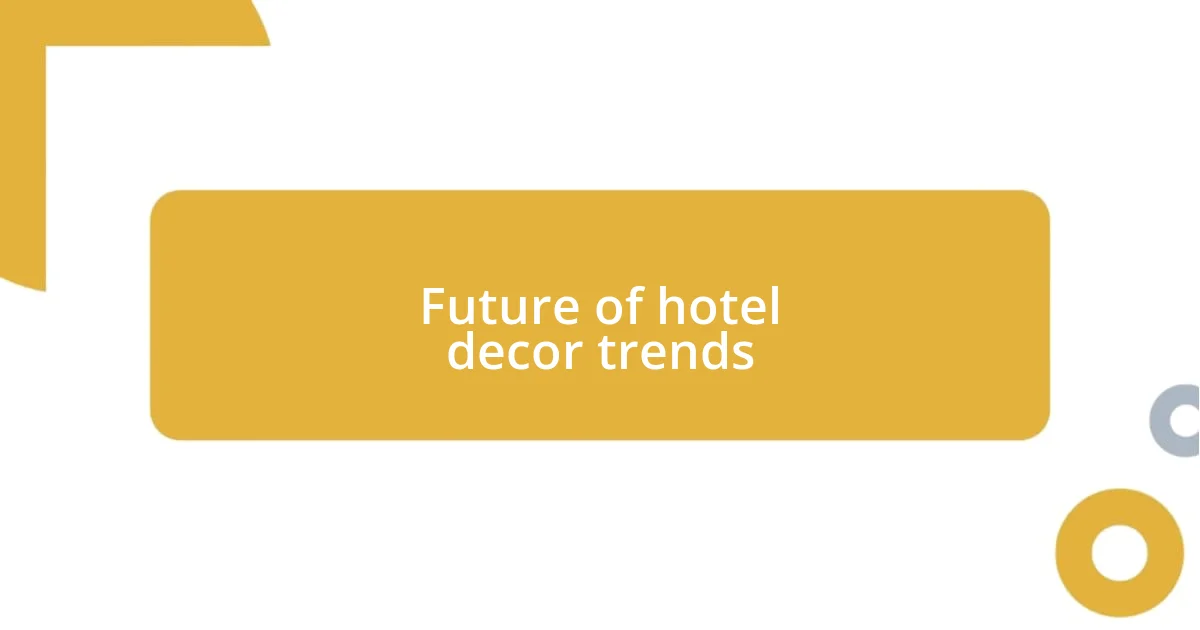
Future of hotel decor trends
As I envision the future of hotel decor trends, I see a strong emphasis on personalization. I’ve stayed in hotels that offered customizable room settings, from adjustable lighting to scent options. Being able to tailor my experience made me feel uniquely catered to, as though the space was designed just for me. Isn’t it exciting to think about how this level of personalization could elevate our overall stays?
Moreover, I can’t help but think about the rise of multi-functional spaces. During a recent visit to a hotel, I discovered a lounge area that seamlessly transformed from a workspace during the day to a cozy gathering spot at night. It struck me how this adaptability can cater to diverse guest needs, making the experience more versatile and inviting. What if every hotel could offer such flexibility, allowing for both productivity and relaxation?
Lastly, I foresee a continued commitment to local culture in decor choices. I remember walking into a hotel that proudly showcased local artists’ work and materials sourced from nearby artisans. The connection to the community enhanced not just the aesthetics but also made me feel more engaged with the destination. Isn’t it inspiring how incorporating local elements can create a more authentic and enriching experience for guests? The future of hotel decor seems poised to celebrate individuality, adaptability, and local heritage in ways that resonate deeply with our evolving expectations.










